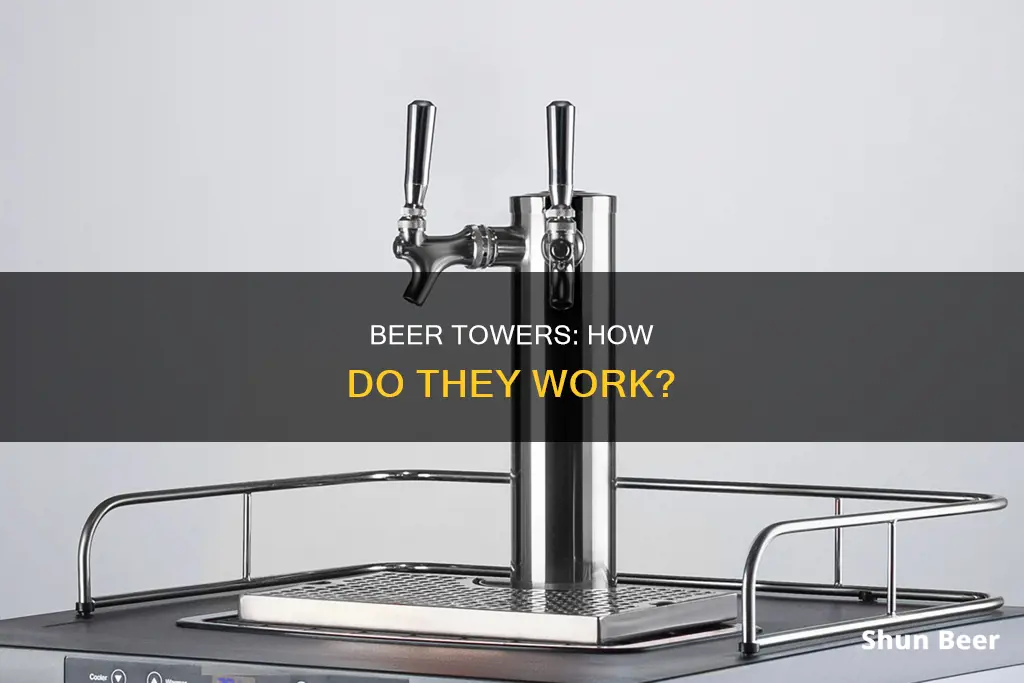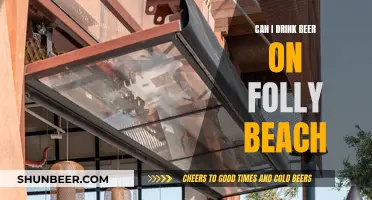
A beer tower, also known as a beer tap tower, draft arm, portable beer tap, tabletop beer dispenser, triton dispenser or beer giraffe, is a device used to dispense beer. Beer towers are commonly found in bars, pubs and restaurants, and are popular in Southeast Asian and Australian drinking establishments. Beer towers come in a variety of sizes, styles and materials, and can be used to serve different types of beer. They are usually chilled using ice chambers, freezable ice packs, glycol coolant or air cooling systems. The beer is then dispensed through a tap or designed pouring mechanism.
| Characteristics | Values |
|---|---|
| Purpose | Allow groups of people to serve themselves beer without ordering individually |
| Dispense mechanism | Simplified beer tap or designed pouring mechanism |
| Dispense valves | Can have multiple valves to allow for simultaneous dispense |
| Chilling mechanism | Ice chambers, freezable ice packs, glycol-cooled draft system, or air-cooled draft system |
| Size | Varies, often double to triple the size of standard beer pitchers (48–60 US fluid ounces/1.4–1.8 L) |
| Shapes | Cylindrical, T-shaped, double-pedestal, wall-mounted, underbar mounted, speciality shapes (e.g. ceramic, wooden barrels) |
| Faucets | Can have a single faucet or multiple faucets (up to 20) |
| Compatibility | Can be used with different cooling systems (glycol-cooled or air-cooled) and different types of kegs |
| Customisation | Customisable towers are available, allowing users to choose faucets, faucet knobs, and other features |
What You'll Learn
- Beer tower types: standard, T-shaped, double-pedestal, wall-mounted, underbar mounted, specialty
- Beer tower sizes: most are double to triple the size of standard beer pitchers
- Beer tower chilling: ice chambers, freezable ice packs, glycol-cooled, air-cooled
- Beer tower uses: self-service, less mess than pitchers, increased volume
- Beer tower history: the ancestor of the modern beer tower was called a portable keg tap or picnic tap

Beer tower types: standard, T-shaped, double-pedestal, wall-mounted, underbar mounted, specialty
Standard Beer Towers
The standard beer tower, also known as a draft arm, is the classic cylindrical tower that is mounted on top of a kegerator, bar top, or counter. It is straightforward, easy to install, and can hold up to three taps, making it ideal for direct draw systems.
T-Shaped Beer Towers
T-shaped towers, also known as T-towers, are popular in commercial settings as they offer more tap options, typically ranging from 2 to 8. They work with both air-cooled and glycol-cooled systems and are characterised by a cylindrical base with a box-shaped top where the faucets are attached.
Double-Pedestal Beer Towers
Double-pedestal towers, also known as pass-through towers or H-towers, are ideal for high-volume environments as they can hold up to 20 faucets. They are commonly used in bars, pubs, and restaurants that offer a wide variety of draft beers. These towers are designed for heavy-duty use and can handle large volumes of beer.
Wall-Mounted Beer Towers
Wall-mounted towers are perfect for spaces where there is limited counter or bar space. They can be installed on a wall, allowing you to serve a large variety of beers (up to 12 taps) without taking up valuable counter space. They are often used when a walk-in cooler is behind a wall where the tower is installed.
Underbar Mounted Beer Towers
Underbar mounted towers are similar to wall-mounted towers in that they save space by being mounted under the bar or counter. They are compatible with air and glycol-cooled systems and can hold up to 12 faucets, making them a versatile option for establishments with limited bar space.
Specialty Beer Towers
Specialty towers are for those who want to make a statement. They are custom-made from materials like ceramic, wood, black iron, or stainless steel, and can be designed to fit specific themes or designs. They offer a unique touch to your setup while still providing the functionality of a standard beer tower.
Beer Breakdown: Understanding Its Effect on the Human Body
You may want to see also

Beer tower sizes: most are double to triple the size of standard beer pitchers
Beer towers come in a variety of sizes, but most are double to triple the size of standard beer pitchers, which hold around 48-60 US fluid ounces (1.4-1.8 litres) of beer.
Some beer towers can hold up to 3 litres of beer, or 102 fluid ounces, which is nearly a gallon. This is enough to serve a room full of guests without the need for constant refills.
The Oggi Beer Tower Dispenser, for example, holds 2.75 quarts of beer, or 88 fluid ounces, which is the equivalent of approximately seven 12-ounce beers.
The Hammer + Axe Beer Tower Dispenser, the Goplus Beer Tower Dispenser, and the Lighted Beer Tower with Ice Tube all hold 3 litres of beer, or 101.44 fluid ounces, which is the equivalent of approximately eight 12-ounce beers.
Does Helium-Infused Beer Really Work?
You may want to see also

Beer tower chilling: ice chambers, freezable ice packs, glycol-cooled, air-cooled
Beer towers are used to dispense beer and are commonly found in bars, pubs, and restaurants. They come in a variety of sizes, often double to triple the size of standard beer pitchers, which hold around 48-60 US fluid ounces (1.4-1.8 L) of beer. Beer towers allow several people in a group to serve themselves without having to order individually.
Chilling the beer in a beer tower is typically achieved through ice chambers or freezable ice packs. These can be located internally or externally, with external cooling being more hygienic. However, in draft beer systems, there are other methods to keep the beer chilled:
Air-cooled draft systems
The beer stored in the lines inside the draft tower can be chilled through a flow of cool air from the refrigeration unit where the keg is stored up into the tower.
Glycol-cooled draft systems
This method uses a mixture of glycol coolant running in a line packaged with the beer line, known as a trunk line. The glycol-cooled beer tower has room to fit the trunk line, and the coolant line runs across glycol cooling blocks inside the tower to help keep the beer cool.
Keeping the beer chilled is essential to prevent it from getting warm and pouring foamy, which leads to wasted beer and potential mess.
Beer's Blood-Thinning Effect: Myth or Reality?
You may want to see also

Beer tower uses: self-service, less mess than pitchers, increased volume
Beer towers, also known as beer tubes or beer giraffes, are often used in bars, pubs, and restaurants. They are large, portable beer taps that allow patrons to serve themselves without having to order individually, making them ideal for group settings. Beer towers typically hold a larger volume of beer than standard pitchers, usually double to triple the amount, making them perfect for serving a large group of people.
One of the main advantages of beer towers is the convenience of self-service. Patrons can pour their own drinks at their table, eliminating the need for a server to take individual orders. This not only speeds up service but also allows customers to pour exactly the amount they want. Beer towers are often used for outdoor events like picnics, where they provide a fun and unique way to serve beer.
Another benefit of beer towers is their ability to reduce mess. By serving beer directly from the tower into glasses, there is less risk of spills and drips compared to using pitchers, which must be carried from the bar to the table. Beer towers also have features like drip trays that catch any spills or overflow, keeping the surrounding area clean and dry.
Beer towers are designed to hold a large volume of beer, typically 2 to 3 litres, which is significantly more than standard pitchers. This increased volume is perfect for large groups or gatherings, as it reduces the need for frequent refills. The tower's height also allows for a better flow of beer, with less chance of foaming or spilling, ensuring that every drop is poured into the glass.
Overall, beer towers offer a unique and convenient way to serve beer, providing self-service, reduced mess, and increased volume for patrons. They are a popular choice for bars, pubs, and outdoor events, adding a fun and functional element to the beverage-serving experience.
Understanding Beer Pumps: The Inner Workings Explained
You may want to see also

Beer tower history: the ancestor of the modern beer tower was called a portable keg tap or picnic tap
The ancestor of the modern beer tower was called a portable keg tap or a picnic tap, as it was mostly used at outdoor events such as picnics. These early beer towers were significantly larger than the modern versions we see today. The method behind these devices involved manually pumping air into the beer container, which would then force the beer out of the tap due to the pressure created within the container. There was also a variant with lager beer barrels that stood upright, allowing gravity to force the beer out of the tap, which is the principle behind the modern system.
The concept of beer towers started to emerge during the medieval period. In medieval Germany, beer was stored in wooden barrels, and taverns often used a gravity-fed system to pour beer from these barrels into mugs. This gravity-based system laid the foundation for the development of the modern beer tower.
The 18th century saw a significant advancement in beer dispensing technology with the invention of the beer engine by Joseph Bramah. This hand-operated pump enabled bartenders to draw beer from casks stored in the cellar and deliver it directly to the customer's glass. While the beer engines were not technically towers, they marked a crucial step forward in the evolution of beer dispensing equipment.
In the 20th century, beer towers transformed into the recognisable structures we know today. With innovations in materials such as stainless steel and glass, the modern beer tower became more visually appealing and durable. The vertical design of the tower not only made it an eye-catching addition to bars but also improved the efficiency of serving multiple patrons at once.
Mouthwash and Beer: Effective Mosquito Repellents or Old Wives' Tales?
You may want to see also







